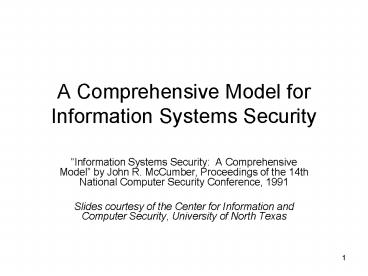A Comprehensive Model for Information Systems Security - PowerPoint PPT Presentation
1 / 13
Title:
A Comprehensive Model for Information Systems Security
Description:
People work better when given a concrete framework in which ... Then appropriateness of technology and policy can be evaluated. 12. Using the Model: A Manager ... – PowerPoint PPT presentation
Number of Views:63
Avg rating:3.0/5.0
Title: A Comprehensive Model for Information Systems Security
1
A Comprehensive Model forInformation Systems
Security
- Information Systems Security A Comprehensive
Model by John R. McCumber, Proceedings of the
14th National Computer Security Conference, 1991 - Slides courtesy of the Center for Information and
Computer Security, University of North Texas
2
Motivation
- Need a common language/terminology in order to
communicate effectively - People work better when given a concrete
framework in which to place abstract ideas
3
States of Information
- Information can be viewed as being in one of
three states - Transmission
- Storage
- Processing
- End-user may not be aware of all state changes
when using information
4
Characteristics of Information
- Information should satisfy the three main goals
of computer security - Confidentiality
- Integrity
- Availability
- Because security and utility often conflict, the
science of information systems security is also a
study in subtle compromises.
5
Security Measures / Controls
- Three main kinds of controls
- Technology
- Policy and Practices
- Education, Training, and Awareness
- These build on one another
- Technology must reflect policy, but policy
can still exist when no technological solution - Policy disseminated through training, but
can have awareness of principles even when no
specific policy
6
The Model
7
Using the Model A Developer
- Starts with an idea of how a system will deal
with information - Identify where information is in each state
- Establish what information characteristics mean
in this application - Consider technical, policy, and
education/training measures to enforce
characteristics in each state - Note that technical isnt always possible,
nor is policy but these can build on each other
8
Example An E-mail System
- Password information states
- Processing Does it need to be kept?
- In the server Only briefly clear
buffers! - In the client maybe longer (to keep from
having to reenter it). Consider obfuscating or
locking memory pages. - Storage Does password need to be stored?
- In the server Some form must be checked.
Store plaintext? Encrypted? Hashed? Separate
authentication server? - In the client Store for later use? Is
this a single-user machine? Any vulnerabilities?
Could password be used elsewhere for something
more sensitive? - Transmission
- Whats visible on the network? Plaintext?
Challenge-response protocol? Inside encrypted
tunnel (SSL/TLS)?
9
Example Client Server DB System
- Information States
- DB stored on disk at the server
- Query processing done at the server
- Results transmitted to the client
- Critical Information Characteristics
- DB should be available 24/7
- DB should be accurate and complete
(integrity) - Only authorized users should access the DB
(confidentiality)
10
Client Server DB System
- Security Measures (consider Technology)
- (Storage, Availability) DB is mirrored
- (Storage, Integrity) Authorized users
perform updates (SQL Grant), changes are correct
(SQL assertions, Domains), backup and recovery
capability - (Storage, Confidentiality) Access control
mechanisms are provided, queries are limited to
prevent disclosure or inference
11
Using the Model An Auditor
- An auditor/evaluator ensures that policy is
properly followed and enforced - Model allows information characteristics and
information states to be evaluated separately
from specific technology - Then appropriateness of technology and
policy can be evaluated
12
Using the Model A Manager
- Managers must set policy
- Its of particular importance that
corporate and government regulations not be bound
by technology. - Policy can be guided by other dimensions,
independent of technology.
13
Conclusions
- A clear model helps
- Give a common terminology for communication
- Give a concrete form to abstract ideas
- Form a framework for designing-in security
- Using a common model across differing roles
(developer, manager, auditor) enables a
consistent and uniform approach to information
security































